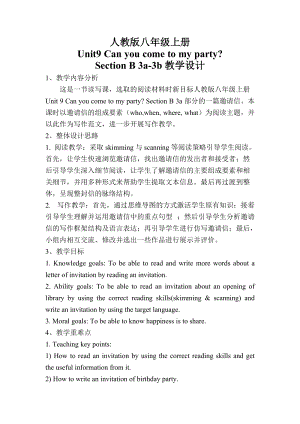人教版八年級(jí)上冊(cè)英語(yǔ)Unit 9 Section B 3a —4-教案-海南省級(jí)優(yōu)課.doc
人教版八年級(jí)上冊(cè)Unit9 Can you come to my party?Section B 3a-3b教學(xué)設(shè)計(jì)1、 教學(xué)內(nèi)容分析這是一節(jié)讀寫課,選取的閱讀材料時(shí)新目標(biāo)人教版八年級(jí)上冊(cè)Unit 9 Can you come to my party? Section B 3a部分的一篇邀請(qǐng)信。本課時(shí)以邀請(qǐng)信的組成要素(who,when, where, what)為閱讀主題,并以此作為寫作范文,進(jìn)一步開展寫作教學(xué)。2、 整體設(shè)計(jì)思路1. 閱讀教學(xué):采取skimming與scanning等閱讀策略引導(dǎo)學(xué)生閱讀。首先,讓學(xué)生快速瀏覽邀請(qǐng)信,找出邀請(qǐng)信的發(fā)出者和接受者;然后引導(dǎo)學(xué)生深入細(xì)節(jié)閱讀,讓學(xué)生了解邀請(qǐng)信的主要組成要素和相關(guān)細(xì)節(jié),并用多種形式來(lái)幫助學(xué)生提取文本信息。最后再過(guò)渡到整體,呈現(xiàn)整封信的脈絡(luò)結(jié)構(gòu)。2. 寫作教學(xué):首先,通過(guò)思維導(dǎo)圖的方式激活學(xué)生原有知識(shí);接著引導(dǎo)學(xué)生理解并運(yùn)用邀請(qǐng)信中的重點(diǎn)句型 ;然后引導(dǎo)學(xué)生分析邀請(qǐng)信的寫作框架結(jié)構(gòu)及語(yǔ)言表達(dá);再引導(dǎo)學(xué)生進(jìn)行仿寫邀請(qǐng)信;最后,小組內(nèi)相互交流、修改并選出一些作品進(jìn)行展示并評(píng)價(jià)。3、 教學(xué)目標(biāo)1. Knowledge goals: To be able to read and write more words about a letter of invitation by reading an invitation.2. Ability goals: To be able to read an invitation about an opening of library by using the correct reading skills(skimming & scanning) and write an invitation by using the target language.3. Moral goals: To be able to know happiness is to share.4、 教學(xué)重難點(diǎn)1. Teaching key points:1) How to read an invitation by using the correct reading skills and get the useful information from it.2) How to write an invitation of birthday party.5、 教學(xué)與學(xué)習(xí)方法1. Teaching methods: Task-based teaching method, communicative approach.2. Learning methods: reading skills(skimming & scanning), cooperating and writing skills(copy writing).6、 教學(xué)過(guò)程Step1: Pre-readingShow a housewarming invitation and ask the students to look at it. Then ask the students to discuss what should mention in an invitation by using some key words.(設(shè)計(jì)意圖:通過(guò)展示一封邀請(qǐng)信,讓學(xué)生知道本課要學(xué)習(xí)的內(nèi)容。再通過(guò)讓學(xué)生討論邀請(qǐng)信包含的內(nèi)容,激活學(xué)生所學(xué)知識(shí),也為下一步學(xué)習(xí)課本中的邀請(qǐng)信做鋪墊。)Step2: While-reading1、 SkimmingAsk the students to look at the invitation on P71 and read it quickly and answer the following questions:(1) Who is making the invitation?(2) Who gets the invitation?(設(shè)計(jì)意圖:通過(guò)快速閱讀,迅速抓住此文的關(guān)鍵要素。) 2、 ScanningAsk the students to read the invitation carefully by using the reading strategy and answer the following questions:(1)What is the invitation for?(2) When will the event happen?(3) What will happen after this?(4) Do parents have to bring anything?(5) How should people reply to this invitation, and when?(設(shè)計(jì)意圖:在抓住關(guān)鍵內(nèi)容的基礎(chǔ)上,進(jìn)行分層語(yǔ)言輸入,即引導(dǎo)學(xué)生深入細(xì)致的閱讀。目的在于讓學(xué)生了解此文的主要意思和細(xì)節(jié),通過(guò)整合教材、降低難度及利用不同的評(píng)價(jià)方式幫助學(xué)生關(guān)注和提取信息,從而使學(xué)生更好地理解此文內(nèi)容。)3、 Useful phrases and sentence structuresAsk the students read the invitation again and find out some useful phrases and sentence structures.E.g. would like to do、will be、after this.(設(shè)計(jì)意圖: 引導(dǎo)學(xué)生找出文中有用的短語(yǔ)、句子結(jié)構(gòu),為下一步寫好短文掃清語(yǔ)言表達(dá)障礙。)Step3: Post-reading1. Pre-writingAsk the students to review what they should mention in a birthday invitation and try to draw a mind map with some key words.(設(shè)計(jì)意圖:通過(guò)思維導(dǎo)圖的方式,讓學(xué)生對(duì)接下來(lái)的寫作框架結(jié)構(gòu)及語(yǔ)言表達(dá)有所準(zhǔn)備。)2. While-writingLet the students write a birthday party by using the target language. At the same time, let three students to write their invitations in front of the class.(設(shè)計(jì)意圖:引導(dǎo)學(xué)生運(yùn)用本課時(shí)所學(xué)的目標(biāo)語(yǔ)言知識(shí)為自己的生日聚會(huì)仿寫一封邀請(qǐng)信,并鼓勵(lì)學(xué)生大膽展示自己的作品。)3. Post-writinga. Ask three students to check the invitations on the blackboard with the standard of writing. And give points to them.b. Let the students check their work with each other in groups and each group choose the best one as the writing star. Then ask group leader to read the best writing to the class.(設(shè)計(jì)意圖:寫作完成后,讓學(xué)生根據(jù)寫作評(píng)分標(biāo)準(zhǔn)對(duì)自己的同伴進(jìn)行評(píng)價(jià)并修改,旨在讓學(xué)生進(jìn)一步了解寫作的評(píng)分標(biāo)準(zhǔn),使學(xué)生以后能更好地書寫。)Step4: SummaryLet the students sum up what they have learned in this class.(設(shè)計(jì)意圖:此環(huán)節(jié)是讓學(xué)生完成任務(wù)后,對(duì)本節(jié)課進(jìn)行反思總結(jié),進(jìn)一步鞏固所學(xué)的語(yǔ)言知識(shí)。)Step5: HomeworkWrite another invitation different from the one in this class and reply to your partners invitation. If you turn down the invitation, give a good reason.(設(shè)計(jì)意圖:運(yùn)用本節(jié)課的目標(biāo)語(yǔ)言及以前學(xué)過(guò)的語(yǔ)言知識(shí),再寫一封邀請(qǐng)信及嘗試有禮貌地回復(fù)伙伴的邀請(qǐng)信,拓寬學(xué)生的知識(shí)面。) Step6: Moral goalAt last, tell the students that happiness is to share. Lets learn to share from now on.(設(shè)計(jì)意圖:通過(guò)本節(jié)課學(xué)習(xí)書寫邀請(qǐng)信,學(xué)會(huì)與人分享幸福、快樂。)Unit 9 Can you come to my party?Section B (3a-3b)Step7:Blackboard design





 網(wǎng)站客服
網(wǎng)站客服
